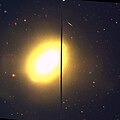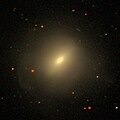NGC 3610
| NGC 3610 | |
|---|---|
 Hubble Space Telescope image of NGC 3610, showing its disk | |
| Observation data (J2000 epoch) | |
| Constellation | Ursa Major |
| Right ascension | 11h 18m 25.276s[1] |
| Declination | +58° 47′ 10.49″[1] |
| Redshift | 0.005694[2] |
| Heliocentric radial velocity | 1,732 km/s[3] |
| Galactocentric velocity | 1,819 km/s[3] |
| Distance | 106 Mly (32.5 Mpc)[4] |
| Apparent magnitude (B) | 11.63[3] |
| Characteristics | |
| Type | E5:[2] |
| Mass | 1.01×1011 (stellar)[4] M☉ |
| Size | 76,800 ly (23,560 pc)[2] |
| Apparent size (V) | 1.460′ × 1.168′[1] (NIR) |
| Other designations | |
| NGC 3610, UGC 6319, LEDA 34566, PGC 34566[5] | |
NGC 3610 is an elliptical galaxy in the constellation Ursa Major.[6] It was discovered on 8 April 1793 by German-British astronomer William Herschel.[7] This galaxy is located at a distance of 106 million light-years (32.5 Mpc) from the Milky Way,[4] and is receding with a galacto-centric radial velocity of 1,819 km/s.[3]
NGC 3610 is a relatively young elliptical galaxy which has not yet lost its disk.[6] It has a morphological classification of E5,[8] indicating a 2:1 ratio between the major and minor axes of the elliptical profile. This is a candidate merger remnant of intermediate age, with a surviving disk of gas and dusk aligned with the major axis.[9] This merger is estimated to have occurred 4±2.5 Gyr ago. The central part of the disk displays warping,[8] and is significantly younger than the remainder of the galaxy.[8]
The unusual amount of blue light emission of NGC 3610, or B–V in the UBV photometric system, suggests recent star formation.[9] The current estimated star formation rate is 0.385±0.375 M☉·yr−1.[4] There is a population of younger globular clusters orbiting the galaxy that is a likely product of the merger. The surviving population of older, metal-rich globular clusters suggests that at least one of the progenitor galaxies had a prominent bulge component.[9]
Gallery
[edit]- NGC 3610 by Hubble Space Telescope
- NGC 3610 (SDSS DR14)
References
[edit]- ^ a b c Skrutskie, Michael F.; et al. (1 February 2006). "The Two Micron All Sky Survey (2MASS)". The Astronomical Journal. 131 (2): 1163–1183. Bibcode:2006AJ....131.1163S. doi:10.1086/498708. ISSN 0004-6256. S2CID 18913331.
- ^ a b c "Results for NGC 252". NASA/IPAC Extragalactic Database. Retrieved 12 February 2017.
- ^ a b c d Tully, R. Brent; et al. (2016). "Cosmicflows-3". The Astronomical Journal. 152 (2). id. 50. arXiv:1605.01765. Bibcode:2016AJ....152...50T. doi:10.3847/0004-6256/152/2/50. S2CID 250737862.
- ^ a b c d Lianou, S.; et al. (November 2019). "Dust properties and star formation of approximately a thousand local galaxies". Astronomy & Astrophysics. 631. id. A38. arXiv:1906.02712. Bibcode:2019A&A...631A..38L. doi:10.1051/0004-6361/201834553.
- ^ "NGC 3610". SIMBAD. Centre de données astronomiques de Strasbourg. Retrieved 12 February 2017.
- ^ a b "A young elliptical". Hubble Space Telescope. Retrieved 16 December 2016.
- ^ Seligman, Courtney. "NGC 3610 (= PGC 34566)". cseligman. Retrieved 12 February 2017.
- ^ a b c Buson, L. M. (September 2010). "The mid-UV population of the nucleus and the bulk of the post-merger NGC 3610". Astronomy and Astrophysics. 519. id. A59. arXiv:1008.0922. Bibcode:2010A&A...519A..59B. doi:10.1051/0004-6361/201014429.
- ^ a b c Howell, Justin H.; et al. (December 2004). "Probing Spectral Line Gradients beyond One Effective Radius in NGC 3610". The Astronomical Journal. 128 (6): 2749–2757. arXiv:astro-ph/0409385. Bibcode:2004AJ....128.2749H. doi:10.1086/425884.
Further reading
[edit]- Bassino, Lilia P.; Caso, Juan P. (April 2017). "The merger remnant NGC 3610 and its globular cluster system: a large-scale study". Monthly Notices of the Royal Astronomical Society. 466 (4): 4259–4271. arXiv:1701.02056. Bibcode:2017MNRAS.466.4259B. doi:10.1093/mnras/stw3390.
- Goudfrooij, Paul; et al. (June 2007). "Dynamical Evolution of Globular Cluster Systems Formed in Galaxy Mergers: Deep Hubble Space Telescope Advanced Camera for Surveys Imaging of Old and Intermediate-Age Globular Clusters in NGC 3610". The Astronomical Journal. 133 (6): 2737–2751. arXiv:astro-ph/0702467. Bibcode:2007AJ....133.2737G. doi:10.1086/516634.
- Strader, Jay; et al. (January 2004). "Revisiting the Globular Cluster System of the Merger Remnant Elliptical Galaxy NGC 3610". The Astronomical Journal. 127 (1): 295–301. arXiv:astro-ph/0310611. Bibcode:2004AJ....127..295S. doi:10.1086/380614.
- Strader, Jay; et al. (February 2003). "Keck Spectroscopy of Globular Clusters in the Elliptical Galaxy NGC 3610". The Astronomical Journal. 125 (2): 626–633. arXiv:astro-ph/0211156. Bibcode:2003AJ....125..626S. doi:10.1086/346086.
- Whitmore, Bradley C.; et al. (July 2002). "The Luminosity Functions of Old and Intermediate-Age Globular Clusters in NGC 3610". The Astronomical Journal. 124 (1): 147–157. arXiv:astro-ph/0205001. Bibcode:2002AJ....124..147W. doi:10.1086/340808.
- Fabbiano, G.; Schweizer, Francois (July 1995). "ROSAT PSPC Observations of Two Dynamically Young Elliptical Galaxies: NGC 4125 and NGC 3610". Astrophysical Journal. 447: 572. Bibcode:1995ApJ...447..572F. doi:10.1086/175900.
- Scorza, C.; Bender, R. (August 1990). "A disk in the elliptical galaxy NGC 3610". Astronomy and Astrophysics. 235: 49. Bibcode:1990A&A...235...49S.
External links
[edit] Media related to NGC 3610 at Wikimedia Commons
Media related to NGC 3610 at Wikimedia Commons


 French
French Deutsch
Deutsch
